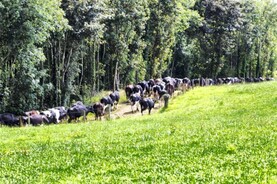
The figures obtained by Eurostat in May and June show a 2.5% rise in the number of Irish dairy cows, compared with last year’s herd. This is in contrast to a 1% fall in the EU as a whole.
“The drop is particularly sharp in the Netherlands with 50,000 dairy cows less. This is linked to the obligation to reduce phosphates emissions,” the European Commission noted.
While the number of German cows fell by a relatively small 1.4%, the herd is so large in Europe’s largest milk producing country that this represents nearly 60,000 fewer cows than last year.
However, the outlook report notes that cow culls have slowed down across Europe as the 2015-2016 milk price slump ended.
Fewer cows, more milk across Europe
The lower number of cows does not translate into a similar cut in milk production. EU milk supply is on course to increase by 0.7% this year, driven by Ireland, Poland and Italy, which are more than making up for declining production in the Netherlands, Germany and France.
Culled cows have been replaced with more productive heifers, good weather conditions across the continent have ensured high forage availability and farmers fed more meal as milk prices recovered.
The European Commission estimates that the average European milk yield is up 2% this year.
Read more
Is the European dairy market reaching ‘tipping point’?

The figures obtained by Eurostat in May and June show a 2.5% rise in the number of Irish dairy cows, compared with last year’s herd. This is in contrast to a 1% fall in the EU as a whole.
“The drop is particularly sharp in the Netherlands with 50,000 dairy cows less. This is linked to the obligation to reduce phosphates emissions,” the European Commission noted.
While the number of German cows fell by a relatively small 1.4%, the herd is so large in Europe’s largest milk producing country that this represents nearly 60,000 fewer cows than last year.
However, the outlook report notes that cow culls have slowed down across Europe as the 2015-2016 milk price slump ended.
Fewer cows, more milk across Europe
The lower number of cows does not translate into a similar cut in milk production. EU milk supply is on course to increase by 0.7% this year, driven by Ireland, Poland and Italy, which are more than making up for declining production in the Netherlands, Germany and France.
Culled cows have been replaced with more productive heifers, good weather conditions across the continent have ensured high forage availability and farmers fed more meal as milk prices recovered.
The European Commission estimates that the average European milk yield is up 2% this year.
Read more
Is the European dairy market reaching ‘tipping point’?







 This is a subscriber-only article
This is a subscriber-only article










SHARING OPTIONS: